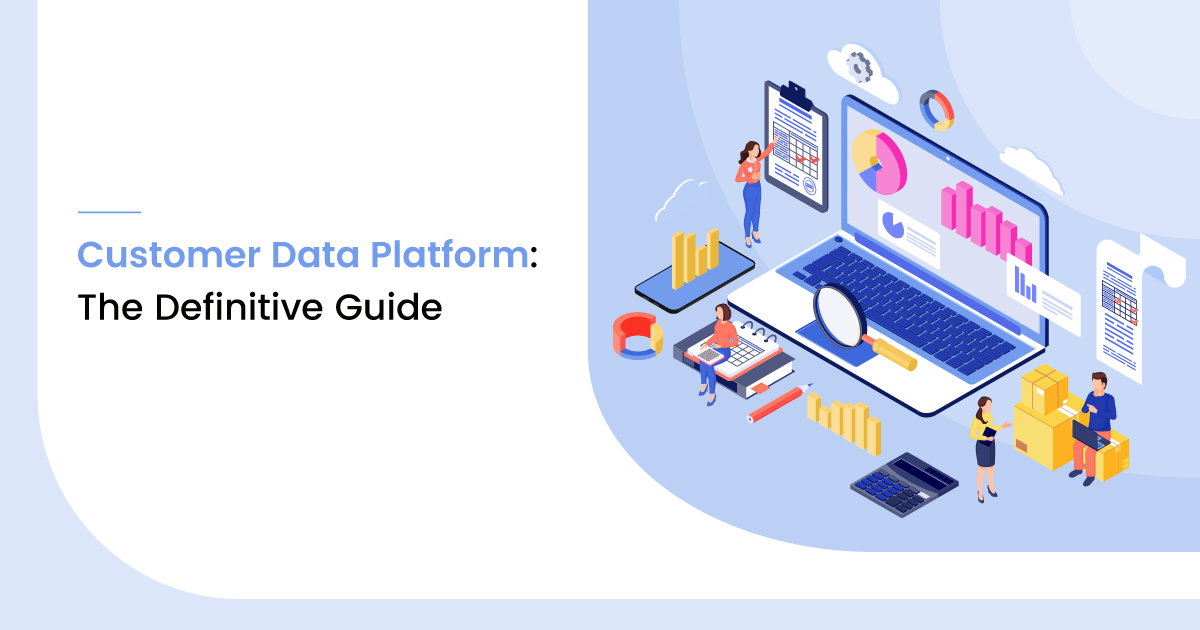Today’s market is customer-centric. Brands no longer do promotions keeping in mind what they offer, but it’s all about what the customer wants.
The interactions that people have with brands while purchasing are quite dynamic and mostly powered by multi-platform browsing. And while doing so, customers are expecting high-end personalization based on their preferences.
So, how do companies ensure to provide a personalized customer-centric experience in which customers get to see the products they are looking for even before they search for it?
The answer lies in the Customer Data Platform!
What is a customer data platform?
The customer Data platform is a software system that collects customer data from various touchpoints and integrates all the available details into a single customer profile.
The information assimilated by CDP is devoid of any duplicate data about the customers. This data is then ingested into automatic marketing tools, which can then be used to implement marketing campaigns for customer acquisition and retention.
CDP provides structured customer data to companies and is centrally available across the organization. It can also be integrated with other marketing tools to improve customer experience.
As per CDP Institute, Customer Data Platform works on three primary pillar elements:
1. It is a packaged software
CDP is meant for marketers, and there’s no longer a dependency on the IT teams to work with data when planning campaigns. CDP is a prebuilt software package that takes care of the company’s data requirements, but it’s not the same as an operating data warehouse.
This reduces the need for a highly-functional technical staff to work on data. The CDP system reduces the overall time and cost of working with data. Marketing teams now require a data analyst at their side to make sense of the customer data profiles for planning campaigns.
2. It provides a singular customer profile
Customers interact with brands through multiple channels. Sometimes they browse through apps, and sometimes it is through web-browser on laptops. This leads to multiple data copies of the same customer. While marketers plan campaigns, there are chances that they may end up targeting the same customer more than once as the data is duplicated.
But CDP consolidates customer data from multiple sources. Removing data redundancy, it gives a singular customer profile for each unique user. Marketers can now implement highly-targeted campaigns without annoying the same users with the same messages more than once.
3. It integrates easily with other tools
The reason for having customer data at hand is to optimize marketing campaigns.
When a customer is checking clothes on an e-commerce app, data is collected from the app and matched with the unique profile of the user.
CDP then feeds this data to the third-party tools that can send push-messages or SMS depending on how to target that particular customer. This way, CDP helps in saving time and cost for marketing campaigns by providing actionable data to existing marketing systems.
From where does CDP collects data?
CDP collects customer data from a number of first, second, and third party resources that include both online and offline mediums.
1. Personal & Behavioral Data
The name, age, gender, address, preferences is collected through customer interactions. Using high-end AI algorithms, CDP can also predict and log customer behavior based on the probability of buying.
2. Customer Action
Data is collected through the activities of visitors on websites by analyzing their session frequency and time, checking the website interactions and actions, through activities performed inside apps, or actions taken on banners and pop-up messages.
3. Customer Transactions
Observing data from purchases made over a period of time, items returned, transactions on POS systems, and wish-list in e-commerce apps, CDP collects transactional customer data.
4. Campaign Data
CDP tracks the data from past campaigns to check the engagements, reach, impressions, click-through rates, etc.
5. Customer Support Data
Data is gathered from the past interactions of customers with the customer support team, from CRM and NPS scores along with bot interactions.
Features of Customer Data Platform
CDP makes the job of marketers a lot easier with its features that help declutter data;
1. Singular Customer Profile
Customer data from multiple channels is collected and resolved to give a single unique customer profile.
2. User Segmentation
CDP identifies similar customer profiles to prepare user segments. These segments are helpful to create and execute targeted marketing campaigns for customer acquisition and retention.
3. Real-time Data Availability
Consolidated customer data is always handy and available with just a few clicks with CDP. Data can be accessed by third-party tools for actionable insights while creating and implementing campaigns.
5. A Complete Data Loop
Data from a single customer profile can be used for marketing purposes. The metrics tracked during past marketing campaigns can be ingested into the existing database to get a data loop that keeps updating itself to get all additional details on each unique user.
Why CDP is a must-have for marketers?
Customer Data Platform is not a new market tool. It has been here for a while. But the question of the hour is why you must have CDP now?
Consider this situation; you are nurturing a potential lead who is now regularly visiting your website, gaining information about your products through your blogs. You are now providing an update in one of your products that this prospect has been monitoring, along with a 20% discount. You want to notify this particular visitor regarding the special discount offer.
But, this visitor has a different time zone than yours. So a mass email campaign won’t do the job of encouraging the prospect to buy your product.
This is where a CDP comes into the picture.
As the buyer’s journey is ever fragmented than before, it has become essential to monitor all the channels that customers use to get insights about their interactions across social media, website, apps, and offline brick-mortar stores too.
Another factor is the demand for high-level marketing automation to boost personalization. Customers want to be treated differently. They no longer want the mass SMS or emails telling them to click for the offer on a product they no longer crave for.
Moreover, the market is about predictive analysis. Data has empowered marketers to be one-step ahead than customers in identifying what they are looking for and providing with the same in the form of pop-ups or in-app messages.
Everything mentioned above is the need of the hour, and CDP is the savior!
Now, this is the question that many marketers have; we already have an in-house CRM system or DMP system, why should we invest in Customer Data Platform?
This is because CDP is a more comprehensive version of data management compared to the other two systems.
Benefits of having a CDP system
While you already have a data management system in your company, there might be certain loopholes that can lead to unsatisfactory results. CDP can fill-in these gaps to help you maximize your ROI and stay ahead in competition;
1. Increase ROI for Your Marketing Efforts
Due to digital disruption, almost every other brand is using Digital Marketing to get results. This, in turn, has reduced its overall impact and business returns too. But when you have a CDP in place, you can provide a personalized experience to customers through omnichannel marketing campaigns. Gartner has predicted that using CDP; companies can sell 20% more than the ones that do not employ personalization.
2. Provide Unparalleled User Experience:
With the choice of plenty, each customer wants a unique experience. 44% of customers are likely to be loyal to the same brand if they receive a personalized treatment and buying experience. (Source – Instapage)
This can be done by administering a seamless buying journey on all the touchpoints that are used by customers. CDP helps in getting all the customer data under one roof, and then using this to monitor customer behavior, marketers can send push notification during the times that the customer is likely to be active. Providing users with something that they are looking for makes them love your brand.
3. Secure Data Management System
When customer data is stored and accessed by multiple tools that are not well-connected, the chances of data leakage are always on the table. With CDP, there is a single system that stores and manages all the sensitive customer information. Even the data transfer between tools is highly secured with layered data protection. CDP thus helps mitigate risks while using customer data.
How to finalize the best CDP for your company?
Until now, if you might have decided that CDP is what you need to invest in, the next step is in finding the right vendor for your company. Depending on the services that you provide, your requirements differ.
So while evaluating the vendor for CDP, first ask yourself these questions;
- What do you want to achieve with a CDP in place?
- Is your current data system insufficient to fulfill your requirements?
Once you get the answers to these questions, carry out thorough market research. When you find vendors that match your requirements, narrow down on the ones that are best fits. While doing so, make sure that they provide features like scalability and flexibility for future usage.
Once you have the winner, ask the vendor to give a trial to let you decide if you want to purchase it or not. Repeat the process till you find the one that is perfect for your organization.
Wrapping up
In a world that is interconnected, customer interactions are highly dynamic. The number of tools that companies use to cater to customers is also changing facets at a greater pace.
In this situation, to stay ahead in the market competition, you must reach the customers before your counterparts do. CDP helps marketers in doing precisely this and more. Get your requirements on paper, finalize your use cases, and see which CDP fits in to reap the benefits of omnichannel marketing.
Need Any Technology Assistance? Call Pursho @ 0731-6725516




